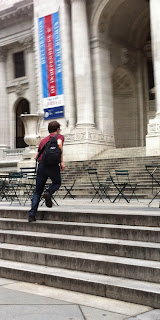P&PC just got back from a fantastic two-week stay in New York City. We rented an apartment in Windsor Terrace, Brooklyn, just across the street from Prospect Park and around the corner from friends living in the trendier and spendier Park Slope. With that as home base, we spent our time visiting, sightseeing, and eating with old friends, taking in museums (The Met, Whitney, and MOMA's PS1), seeing a Broadway show, going to a Yankees game, attending several concerts in Prospect Park including the New York Philharmonic, hitting some flea markets, and sampling what NY had to offer in the way of summertime brews. We hit all five boroughs, had great Puerto Rican food in the East Village, superb Shanghai-style dumplings in Chinatown, mouth-watering Jamaican food in Lefferts Gardens and the Bronx, and walked ourselves out of a new pair of shoes and nearly into a case of plantar fasciitis.
With the exception of a quick dash (that's us—dashing as always—pictured above) into the Public Library to check out and photograph old issues of Popular Poetry magazine (pictured here), we didn't set out to do much in the way of research. But, as always, the research came to us. Is it possible that New York is the city most saturated with poetry in America? Check out the following photos and make the call for yourself.
New York loves Emma Lazarus's 1883 poem "The New Colossus," and while the closest we could get to Liberty Island—where the poem appears on the base of the Statue of Liberty—was the Staten Island Ferry, we did walk past the Park Avenue Methodist Church on the Upper East Side, which is currently quoting the poem's most famous passage "Give me your tired, your poor, / your huddled masses yearning to breathe free" on the sign outside its door.
We also ran across a facsimile of the poem at the City Reliquary, where it's part of a Statue of Liberty display featuring probably more than a hundred kitschy souvenir versions of the Statue. If you haven't been to the quirky, eclectic, three-room museum in Williamsburg, make time in your schedule the next time you go hipster-spotting. There you'll find displays on the 1939 and 1964 World's Fairs, a famous New York barber (along with a photograph album of people whose hair he cut), the dancer Little Egypt who scandalized crowds at the Columbian Exposition, rocks and discarded chunks of buildings from around the city (like a cobblestone from Cobble Hill), and other curiosities curated with a reckless abandon. If you're as lucky as we were, you might even run into a taxi driver-poet.
We, however, didn't take any taxis, preferring to spend our limited allowance otherwise. Instead, we took the subway—one site of the well-known Poetry in Motion initiative coordinated by the Poetry Society of America. Not only are there poem-posters in select subway cars (we kept running into Mary Ruefle's "Voyager" on the F train), but some MetroCards have poems printed on back as well. (The one pictured here was saved for us by our friends in Park Slope.) We have to confess that, more than once on our underground trips around the city, you could have heard us reciting Ezra Pound's "In a Station of the Metro"—a fact that bewildered one of our friend's children who didn't so much as bat an eye when a South American pan flute band stepped on at one station, launched into a short vigorous performance, and departed at the next.
We also did a lot of cool-hunting—not because we're hipsters, but because the weather was hot and muggy, soaring at times into the mid-90s. And even there, the poetry led the way, as this board propped outside of the Bowery Coffee suggests:
We Can Cool You Down,
Get Rid of Your Frown,
And Give You A Smile
That Will Last A While.
Cool-hunting also led us to the Brooklyn Botanic Garden, where we took in the bonzai tree museum and wandered the shady grounds. There, we came across the building pictured to the left which welcomes visitors with two lines mounted above the front door:
He is happiest who hath power
To gather wisdom from a flower
In case you were wondering, the lines are by Mary Howitt (1799-1888), a British writer and translator who, according to Wiki, authored over 100 books by herself and with her husband.
We're no fans of the Yankees, but we're fans of baseball, and so we took in a game at the new Yankee Stadium, stopping beforehand at Fauzia's Heavenly Delights food cart and taking our lunch to eat in Joyce Kilmer Park—named for the World War One-Era American poet, New Jersey native, and onetime Columbia College student. We searched and searched, and while we found a statue of Bronx civic leader Louis J. Heintz (as well as a rat nibbling on french fries and popcorn someone had strewn about), we couldn't find so much as a plaque about Kilmer himself. For a moment we wondered if the leaf design on the sign were a tribute to his famous poem "Trees"—a distillation of the poem to a single image—but then we realized with some dismay that, nope, it's just the logo used by the City of New York Parks & Recreation Department. Damn. The Yankees won as well.
So that's a recap of our time in the Big Apple. We walked the Brooklyn Bridge while quoting Hart Crane. We talked about Whitman with a guy running a flea market stall. And we began reading Catherine Robson's great new book Heart Beats: Everyday Life and the Memorized Poem. We've only been back in Oregon a week, but already our memories are fading—like the faces in a New York subway crowd, perhaps, or like petals on a wet, black bough.
Monday, July 22, 2013
Subscribe to:
Comments (Atom)






















